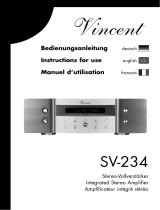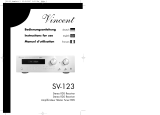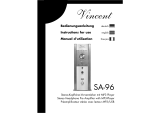24
Vincent
SAFETY GUIDELINES
This appliance was produced under strict quality controls.
It complies with all established international safety standards.
Nonetheless, the following instructions should be fully read and
observed in order to prevent any hazard:
Cleaning
Pull out the plug before cleaning the outside of the
product. Whenever possible, use a soft, lint-free
cloth that has been dampened. Do not use abrasi-
ves, solvents, thinners, flammable chemicals, polis-
hes and other cleaning products that leave marks.
Batteries
Take note of the instructions for using batteries in
the chapter “Remote Control”.
Maintenance/Alterations
All equipment that is connected to the domestic
mains voltage can be dangerous to the user if not
handled properly. Leave maintenance work to
quali fied professionals. The product is only per-
mitted for connection to AC 230Volt/50Hz, for
earthed sockets and use in enclosed areas.
Altering the product or manipulating its serial num-
ber voids the warranty. After a fault, leave the
appliance’s fuse to be replaced only by a profes-
sional with one of the same kind.
Power Cable Connection
Always pull the plug and never the power cable if
you want to disconnect the appliance from the
mains power. Make sure when setting up the
appliance that the power cable is not squashed,
severely bent or damaged by sharp edges.
Do not touch the power lead with wet or damp
hands. Use the power cable supplied or another
one from Vincent.
Switching Off
Switch the appliance off every time before you
connect or remove other components or loudspea-
kers, disconnect or connect it to the mains power,
leave it unused for a longer period or want to
clean its outside. On all amplifiers and receivers,
wait approx. 1 minute after this before disconnec-
ting or reconnecting the cable.
Moisture/Heat/Vibration
Contact of electrically operated equipment with
liquids, moisture, rain or water vapour is dange-
rous for such equipment and the user and must be
avoided without fail. Take care that no liquids or
objects get inside the appliance (ventilation slots
etc.). It must be disconnected from the mains power
immediately and examined by a professional if
this happens. Never expose the appliance to high
temperatures, direct sunshine or strong vibration.
Heat Build-up
All amplifiers generate heat as part of their
design. Make sure that a gap of 5 cm remains
around the appliance and that the surrounding air
can circulate (do not install in enclosed cupbo-
ards). Vents must not be covered up.
Volume
The maximum tolerable volume is always reached
well below the maximum possible setting on the
amplifier. Be careful with the volume setting, there-
fore, in order to prevent damage to hearing. So that
you do not expose yourself to high volumes uninten-
tionally, always set to a low level before changing
the input channel.






















